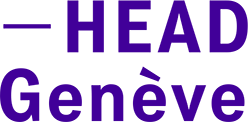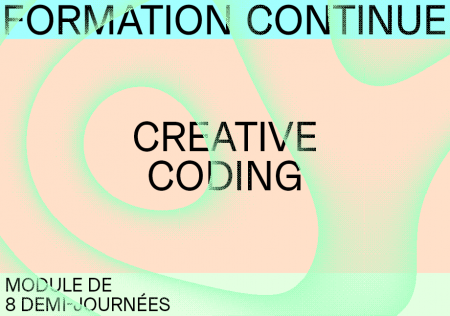- The school
- Studies and Research
- BACHELOR
- MASTER
- DOCTORATE
- RESEARCH
- TRANSDISCIPLINARITY
- POOLS
- CONTINUING EDUCATION
- Continuing education 2025-2026
- Artificial Intelligence, initiation
- Artificial Intelligence, Advanced
- Artificial intelligence open-source, ComfyUI
- Creative coding
- Engage with drawing
- Frame-by-frame animation
- 3D exhibition modeling in SketchUp
- 3D modeling, Blender
- Point cloud scanning
- Documentary podcast
- Serious games
- For students
- Studying at the HEAD
- InfoLab
- Living in Geneva
- Tuition fees and sholarship
- Library
- Regulations and instructions
- Projects
- Events
- Press
- Partnerships and prizes
Creative coding
Give artists and designers direct access to the creative potential of machines.
The “vibe coding” phenomenon has opened up the possibility of asking a machine to write code for us. Even if the results are still sometimes approximate, this development makes programming more accessible to creators who want to push their machines further without, until now, having dared to try their hand at coding.
This dynamic is in line with the “creative coding” movement, initiated over twenty years ago, which aims to develop programming tools adapted to artists, designers, architects and authors, enabling them to explore digital technology according to their intuitions, sensibilities and creative methods.
Drawing on the history of generative art, participants will build elementary forms that gradually become complex, evolving compositions. Through concrete exercises, and in dialogue with accompanying chatbots, they will understand the basic logic and syntax of a program and learn how to use it to create posters, images, animations, books, video installations or evolving websites.
Targeted skills
Target audience
This course is aimed at professionals or students in the arts, design or architecture wishing to enhance their practice with emerging technologies, as well as anyone wishing to explore the creative potential of machines.
Targeted skills
Knowledge of the creative coding approach, based on the latest developments in chatbots.
Be familiar with key works in the history of art and generative design.
Master the basics of artistic programming using tools such as P5.js.
Learn about data visualization, transforming data into visual forms.
Be able to produce a generative form in the form of a poster, web page, animation or book.
Course format
The course alternates between :
Pre-prepared videos containing theoretical explanations and practical exercises to explore at home, at your own pace.
Face-to-face sessions where the results of these exercises will be analyzed and discussed collectively.
Prerequisites
No technical skills required, apart from basic computer skills (word processing, file management).
Course duration: 8 half-days
Dates :
Fee: 1200 CHF / HEAD – Genève alumni 900 CHF
Language: French (English possible)
Certification : Attestation de formation continue
Credits : equivalent to 2 ECTS
Location: Campus HEAD, Building E, Av. de Châtelaine 5, 1203 Geneva, and online
Course duration: 8 half-days
Dates :
- Friday 6 March 2026 from 1:30pm to 5:00pm
- Saturday, March 7, 2026 from 9:00am to 12:30pm
- Friday, March 13, 2026 from 1:30pm to 5:00pm - On-line
- Saturday, March 14, 2026 from 9:00am to 12:30pm
- Friday March 20, 2026 from 1:30pm to 5:00pm - On-line
- Saturday, March 21, 2026 from 9:00am to 12:30pm
- Friday March 27, 2026 from 1:30pm to 5:00pm - On-line
- Saturday, March 28, 2026 from 09:00am to 12:30pm
Fee: 1200 CHF / HEAD – Genève alumni 900 CHF
Language: French (English possible)
Certification : Attestation de formation continue
Credits : equivalent to 2 ECTS
Location: Campus HEAD, Building E, Av. de Châtelaine 5, 1203 Geneva, and online
See detailed program
Teaching methods
Pre-prepared videos, face-to-face sessions, personalized follow-up, experimentation sessions and project coaching.
Day 1
A short history of generative art
Introduction to P5.js
First steps in shape generation
Interactivity
Day 2
Setting up Creative Coding tools
“Hello Computer”, or how to talk to robots
Some basic notions: variables, loops, functions
Day 3
Advanced exercises
Creation of a drawing machine
Day 4
Other questions
Synthesis of concepts
What is an object?
Day 5
Advanced exercises
Data visualization: how to draw with information
Defining a personal project
Day 6
Miscellaneous questions
Synthesis of concepts
Perfecting your personal project
The art of movement: linear, random, sinusoidal, noise
The role of color: RGB, HSB, Blend Modes
The basics of the three Ds
Day 7
Personal project work
Project follow-up
Day 8
Exhibition of completed projects
Final synthesis
Group feedback
Course led by :
Douglas Edric Stanley
American-born artist Douglas Edric Stanley works primarily in the field of new media and more specifically on the relationship between algorithms and aesthetics. As an artist, designer, curator, developer and theorist, he focuses on the way various disciplines are transformed by the progressive “algorithmisation” of the world. Active in the video game industry and in experimental forms of play, he is the joint founder with Antonin Fourneau of the monstre-à-n-têtes also known as ENIAROF. He has led numerous creative coding and experimental game design workshops for various museums, associations, universities and art schools and has participated as an artist in several exhibitions related to computer art.
Information and registration/admission
Contact: fc.head@hesge.ch
Registration form
General terms and conditions

